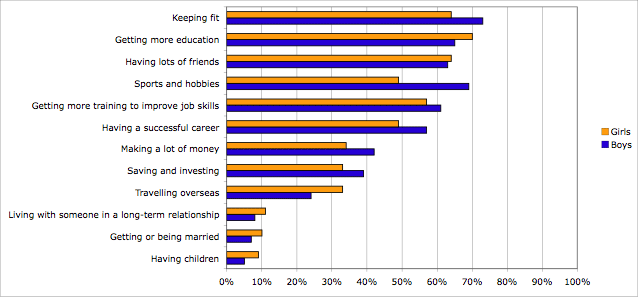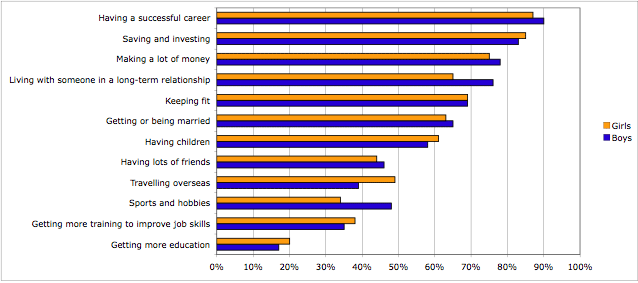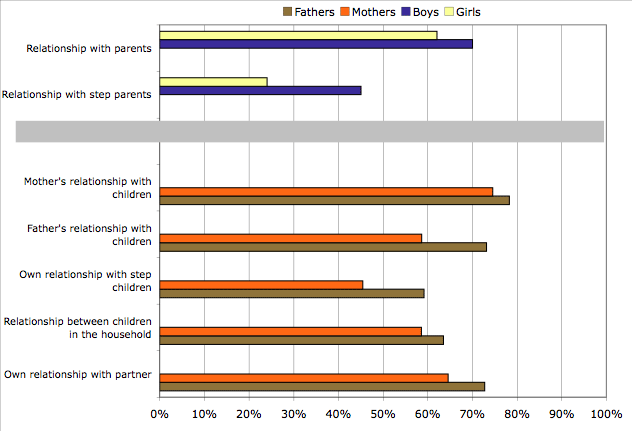Snapshots of Australian families with adolescents
You are in an archived section of the AIFS website
May 2006
Download Research snapshot
Overview
Over the last few generations the composition of families and the roles and responsibilities of parents have changed substantially. Despite these transformations, the family unit remains the foundation of society and the place in which children are nurtured as they grow to maturity.
The statistics presented in this Facts Sheet are drawn from the 2001 Census, Wave 4 of the Household, Income and Labour Dynamics in Australia (HILDA) survey (2004) and several Australian Bureau of Statistics publications.
Families with adolescent children
Young people aged 12 to 18 years are going through a crucial transition period - from childhood to adulthood. This period involves marked physical, cognitive, emotional and behavioural changes, with issues of independence and freedom coming to the fore. It can be a challenging time for both young people and their parents. The way this transition progresses has important long-term repercussions for the emerging adult, their parents and society at large.
Family type in 2001
- There were 1.1 million Australian families with adolescent children aged 12 to 18 years
- 76% were couple families and 24% were sole parent families
- 83% of sole parent families were headed by mothers
- 40% of families with adolescent children also had caring responsibilities for children aged less than twelve years
Parents' employment circumstances
- 68% of mothers and 85% of fathers were in paid work
- In 66% of couple families, both parents were in paid work
- In 21% of couple families, the father was the sole breadwinner
- In 5% of couple families, the mother was the sole breadwinner
- Dual joblessness (where neither parent was in paid work) applied to 9% of couple families
- 57% of sole parents were in paid work
- One-third of employed fathers worked more than 48 hours per week
Residential location and country of birth
- 60% of families were living in metropolitan areas 1
- In most families, both parents were born in Australia, though migrant families were not uncommon
- In 26% of families, both parents were born overseas and in 14% one parent was born in Australia and the other was born overseas
- Among migrant families (where at least one parent was born overseas), 44% of mothers and 45% of fathers were from European countries or New Zealand
- 32% of mothers and fathers in migrant families were from Asian countries
- Dual joblessness was more common among migrant families than other families - 15% compared with 6%
Adolescent children
Education and work
- In 2005, 1.9 million Australians were 12-18 years old, accounting for 9.6% of the Australian population, down from 12.7% in 1971
- Over the last few decades, an increasing proportion of adolescents have completed secondary education
- In the 1970s, about one-third of students who entered secondary school completed Year 12
- By the late 1990s three-quarters of those who entered secondary school had completed Year 12
- In 2001, 52% of adolescents aged 15-18 were studying and not in paid work, 26% were studying and in paid work, 12% were work only, and 7% were neither studying nor in paid work
Issues seen as important: now and in the future
In 2004, young Australians aged 15-18 years old were asked to indicate how important 12 life issues were to them currently and how important they felt these issues would be to them when they were 35 years old.2
Figure 1 shows the issues that were considered as currently important by adolescents.
- At the top of the list for both girls and boys were keeping fit, getting more education, and having lots of friends
- Boys also saw engaging in sports and hobbies as important (69% of boys compared with 49% of girls)
- Boys were more likely than girls to attach high importance to the things that would help them to get ahead in life such as having a successful career, making a lot of money and saving and investing
- Forming relationships and having children tended to be emphasized more by girls than boys, although few considered these issues to be currently important to them
- Travelling overseas was considered important by more girls than boys (33% versus 24%)
Figure 1: Adolescents aged 15-18 years: Proportion of boys and girls who attached importance to various issues *

* 'Importance' refers to ratings of 8-10 on a scale ranging from 0 'Not at all important' to 10 'Very important'.
Figure 2 shows that adolescents believed that their life priorities would change considerably by the time they were 35 years old.
- The most commonly predicted priorities for both boys and girls were having a successful career, saving and investing, and making a great deal of money
- While few adolescents currently attached importance to family formation, most expected that these matters would be important to them at age 35
- Boys were more likely than girls to see themselves as attaching high importance to living in a long-term relationship (76% of boys compared with 65% of girls)
- Around 60% of boys and girls felt that they would attach high importance to having children by age 35
- Keeping fit was rated as very important by most adolescents at the time of the survey (73% of boys and 64% of girls) and was expected to remain important at age 35 (69% of both boys and girls)
- Over 60% rated having many friends as currently important but this fell to less than 50% when adolescents rated importance at age 35
- Boys were more inclined than girls to emphasise sports and hobbies both currently and in the future, but again the importance of this issue was expected to diminish by age 35
- Most adolescents currently emphasised the need for more education but did not expect to attach high importance to this issue when 35 years old
Figure 2: Adolescents aged 15-18 years: Proportion of boys and girls who believed they would attach importance to various life issues when they were 35 years old *

* 'Importance' refers to ratings of 8-10 on a scale ranging from 0 'Not at all important' to 10 'Very important'.
Satisfaction with family relationships
In the same 2004 survey, parents of adolescents aged 12-18 years and adolescents aged 15-18 years were also asked to indicate how satisfied they felt with relationships in the family.
Figure 3 shows: (a) the proportions of boys and girls aged 15-18 years who were very satisfied with their relationship with their parents and step-parents2; and (b) the proportions of fathers and mothers living with adolescents aged 12-18 who were very satisfied with their relationship with their partner, children, and step-children, and with the relationship between the children living with them. Many of these households also included children younger or older than 12-18 years.
- 70% of boys and 62% of girls were very satisfied with their relationship with their parents
- Only 45% of boys and 24% of girls expressed high satisfaction with their relationship with step-parents
- For parents, mother-child relationships were the most likely to be viewed in a very favourable light
- 74% of mothers expressed high satisfaction with their own relationship with their children
- 78% of fathers expressed high satisfaction with their partner's relationship with their children
- Father-child relationships were also considered very favourably
- 59% of mothers expressed high satisfaction with their partner's relationship with their children
- 73% of fathers expressed high satisfaction with their own relationship with their children
- 73% of mothers and 65% of fathers were also very satisfied with their relationship with each other
- 63% of mothers and 59% of fathers were very satisfied with the relationships between the children who were living at home
- 59% of fathers and 45% of mothers indicated high satisfaction with their relationship with their step-children (most step-fathers, but not step-mothers, would have been living with their step-children)
- In general, higher proportions of males (fathers and sons) than females (mothers and daughters) indicated high satisfaction with family relationships, with this difference being most marked for step-relationships and for fathers' relationships with the children
Figure 3: Parents and adolescents: Percentage indicating high satisfaction with various family relationships*

* 'High satisfaction' refers to ratings 8-10 on a scale ranging from 0 'Completely dissatisfied' to 10 'Completely satisfied'.
Conclusion
Adolescence is a period of transition from childhood to adulthood. While it can be a difficult time for the adolescents themselves and their families, this snapshot suggests that most Australian adolescents are 'travelling' well. The vast majority of young people are actively engaged in study and/or work, and most are focusing on being fit, furthering their education and having many friends. These pursuits are likely to stand them in good stead for the future - with most setting their sights on achieving a successful career and financial security, and having a partner and children. In the meantime, most adolescents appear to get on well with their families, with parents and their adolescent children deriving much satisfaction from their relationships with each other.
Sources
- Australian Bureau of Statistics. 2001 Census 1% Household Sample File.
- Australian Bureau of Statistics (2005). Population by Age and Sex, Australian States and Territories, June 2005. (Catalogue No. 3201.0) Canberra: Australian Bureau of Statistics.
- Australian Bureau of Statistics (1997). Youth, Australia: A Social Report. (Catalogue No. 4111.0). Canberra: Australian Bureau of Statistics.
- Australian Bureau of Statistics (2004). Australia Social Trends 2004. (Catalogue No. 4102.0). Canberra: Australian Bureau of Statistics.
The analysis for Issues seen as important and Satisfaction with family relationships is based on Wave 4 of the Household, Income, and Labour Dynamics in Australia (HILDA) Survey. The survey is funded by the Australian Government through the Department of Families, Community Services and Indigenous Affairs. It is managed by the Melbourne Institute of Applied Economic and Social Research (the lead agency), in collaboration with the Australian Institute of Family Studies and the Australian Council for Educational Research.